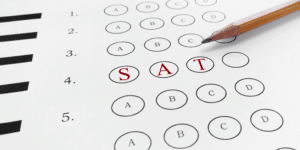Duck, duck . . . goose!
Mother, may I take two giant steps?
Yes, you may.
Mother, may I take four baby steps?
No, you may not.
Simon says, Touch your nose.
Simon says, Turn around.
Simon says, Jump up and down.
Now stop!
I didn’t say, ‘Simon says’!
The refrains from the traditional games that many of us played as children — and that many children play today — are not just the sounds of children having fun. They are also the sounds of children learning!
The skills children practice when playing these games are not only important on the playground, but also in social and educational settings. Why? At the heart of each of these games is a crucial skill: executive functioning.
Executive Functioning: Definition
Executive functioning has three components:
- Attentional flexibility: the ability to pay attention to instructions, ignore distractions, and switch focus from one task or person to another (e.g., listening expressly for the words “Simon Says”)
- Working memory: the ability to keep information in your mind long enough to follow through with instructions (e.g., remembering to stay still if tagged “duck” and to run if tagged “goose”)
- Inhibitory control: the ability to stop and respond in a way that might feel less natural, but is more appropriate (e.g., refraining from disregarding the wishes of the “mother” when those differ from what is requested)
When the components of executive functioning come together to determine behavior, this is called self-regulation. Simply put, self-regulation is the ability to stop, think, and then make a choice before acting. Children demonstrate self-regulation in many ways: they stop and ask for what they want rather than having a tantrum; they take turns with friends while playing a game; they pay attention during a story; they wait in line; and they follow directions. Research shows that children with strong self-regulatory skills are better prepared for school and have stronger social and academic outcomes than their peers who struggle to master these abilities.
There are many factors that affect the development of self-regulation. These include the relationship between the child and her parent/caregiver, the child’s temperament and personality, her age and brain maturation, her exposure to models of strong self-regulation, practice, and experience.
The good news is that research is showing that executive functioning and self-regulation can be practiced and improved! Here are a few tips for helping the children in your life develop self-regulation. There are two key ways to help your child cultivate self-regulation: modeling it yourself, and supporting your child’s development of it through activities and games.
Modeling Self-Regulation
Children learn by watching and emulating the models in their lives, including parents, caregivers, siblings, and teachers. If these adults in a child’s life model strong self-regulatory skills, children will be better supported in developing their own skill sets. Here are three ways that you can model self-regulation for your child.
1. Look for opportunities to model self-regulation throughout your day.
For example, if you pick up a dessert on your way home from work, rather than taking a bite in the car, say out loud, “I’m going to save this and wait to eat it after dinner because that’s when we will all have dessert!” By sharing your “private speech” with children, you can point out your own self-regulatory abilities and explain your choices — and, in turn, help children learn to exercise the same skills in their own lives.
2. Share out loud with your child the choices you make.
Sharing can be about simple choices or more complex choices, depending on the age of your child. For example: “When the light turns red, I stop the car because it is someone else’s turn to go. Now the light is green, so we can go.” Or: “I was having a lot of trouble concentrating at work today because I kept thinking about all the things we need to do to get ready for our trip this weekend! I had to keep reminding myself that I would have time to pack later tonight. Do you ever feel that way at school? What do you do to stay focused?” Sharing stories and asking questions both help promote critical thinking and encourage children to consider what they do and why.
3. Turn off technology, and be present with your child.
It can be tempting to check email on your smartphone while also spending time with your child, but try to refrain from doing this. Instead, let your child know about this struggle: “I have a lot of emails from work, so I keep looking at my phone, but I’m going to put it away right now. This is family time, and I really want to spend time together without getting distracted.” Not only does this model self-regulation to your child, but it also helps build a stronger bond.
Supporting Your Child’s Development Through Activities and Games
Several intervention programs have emerged showing that children can practice and develop self-regulation through activities, songs, and games. Children learn through play, and making learning fun is a terrific way to promote self-regulation at home. Here are three more things you can do to support your child’s development.
1. Make use of all “boring” time.
When standing in line at the grocery store, driving in the car, or while waiting for the bus, sing songs or play games with your child. You have a range of activities available to you: playing games like I Spy, searching for certain color cars that pass by, identifying letters on signs or magazines in the order of the alphabet, or pointing out license plates from each state. These games teach children that there are fun and appropriate ways to occupy their minds when they do have to wait. We often have an expectation that children should be patient while waiting, but we need to teach them how — and what to do during these times!
2. Engage together in activities that require focus.
By completing puzzles or reading books with your child, you can help bring these activities to life. Your child will also be more likely to find these things fun if you’re showing interest in them (another instance of modeling). Working together will also help develop your child’s attention skills and extend the amount of time your child can spend on a given activity.
3. Play games that require turn-taking.
These can be board games or more active games like hide-and-seek. Games that have complex rules like Simon Says or Red Light, Green Light help children practice each of the components of executive functioning and self-regulation. You can even add new twists to these games. For example, you could ask children to touch their heads if you say a word that starts with the letter “H,” to touch their toes if you say a word that starts with the letter “T,” and to wave their hands in the air if you say a word that starts with a different letter.
Learning More
To find out more about how executive function and self-regulation develop, and to discover additional game and activity ideas, check out these resources:
Books
- Stop, Think, Act: Integrating Self-Regulation in the Early Childhood Classroom by Megan M. McClelland and Shauna L. Tominey
Online Resources
- Developing Self-Regulation in Kindergarten by Elena Bodrova and Deborah J. Leong
- Developing Young Children’s Self-Regulation Through Everyday Experiences by Ida Rose Florez
- Self-Regulation: A Cornerstone of Early Childhood Development by Linda Groves Gillespie and Nancy L. Seibel
Journal Articles
- McClelland, M. M. & Tominey, S. L. (2014). The development of self-regulation and executive function in young children. Zero to Three Journal, 35(2), 2–8.
- Tominey, S. L., Olsen, S. G., & McClelland, M. M. (2015). Supporting the development of emotion regulation in young children: The important role of the parent-child attachment relationship. International Journal of Birth and Parent Education, 2(4).




